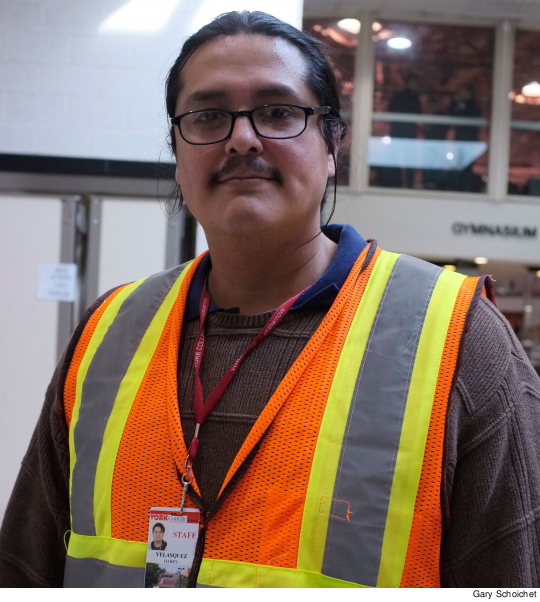When Superstorm Sandy pushed a record storm surge into New York harbor, thousands of people were evacuated from sea-level neighborhoods. Many ended up in shelters on CUNY college campuses, including York College in Jamaica, Queens. A week after the storm hit, 630 people were still housed in York’s academic building, while 175 in need of medical care were in the gymnasium just across Guy R. Brewer Boulevard.
Inside the main building, army cots with New York City blue blankets lined the hallways and open floors. Some people brought their own blankets and quilts for double warmth and maybe a feeling of home. During the day, most of the 630 evacuees were out: at work, at their ruined or powerless homes, or just to take a break. Some people slept, as kids ran around trying not to make too much noise. Some watched Kung Fu Panda 2 in the auditorium where films were being shown 24 hours a day.
Peace and Public Safety
York College employees, City workers, FEMA workers and volunteers kept the intake process moving smoothly, the floors and toilets clean, and interactions peaceful. With so many people in distress and living in frustration, anxious to return to their homes (if they still had one) and their pre-Sandy lives, the college’s public safety officers were charged with keeping the peace. “The guys here have been doing a great job,” said Stephen Barrera, HEO delegate for public safety. “They’re working 12-hour shifts and sleeping on campus. Last year it was Hurricane Irene for three to five days; it was a blur. The college is doing a great thing.”
Rishi Nath, associate professor of mathematics and director of the Queens Community College (QCC) Office of Undergraduate Research, had been either at York or in the Rockaways since the storm’s arrival a week before. Nath got dispatches from the college and sent out e-mails to keep PSC members informed. “The teaching staff has had to step down while this other function has to be served,” he told Clarion. “It’s interesting how important the public safety officers have become. It’s important and illuminating for all of the faculty to see this. They’ve done an amazing job.”
 |
York student Harry Velasquez works part-time at the college as an ET (Education Technician). He’s 42 years old, majoring in psychology and sociology. “I’ve been here every day. I haven’t gone home once,” he said on November 5, 2012. Velasquez was responsible for the movies being shown. “People have to have a place to relax,” he explained. Velasquez also worked on getting the school’s media equipment out, for evacuees to use, and ran a charging station for cell phones and computers. “I’ll be here to the end,” he said.
Stephanie, one of the evacuees at York, spoke with Clarion while another evacuee, Marie, braided her hair. Her home in the Rockaways was without electricity or heat. “Otherwise,” she said, “it’s fine.” With two daughters, one a toddler and the other an infant, Stephanie has her hands full in the shelter. While happy to be warm and indoors, she was anxious to get home to see the damage and to begin getting her life back together.
Anna Johnson, 24, a recent college grad from Minnesota, came to New York City as a volunteer with the Conservation Corps of Minnesota and Iowa. “I’ve always wanted to help with disaster relief. I went to New Orleans after Katrina, moving debris and cleaning,” she said. “It makes me happy to help people.” In the beginning she worked in a large room at the college where piles of clothes were sorted by gender and size; now she guards the hallway that leads to one of the family sections. “Everything helps,” she said. “I’ll stay as long as they need us.”
Walking through York College with Rishi Nath was like touring a small town with the mayor. He knew everyone; everyone knew him. “York College provided the citizens of our neighboring community with a safe, hygienic, welcoming place in a turbulent time and has treated evacuees with respect and the dignity they deserve,” Nath told Clarion. “As a faculty member, it’s a bright moment in an otherwise dark time.” Of the ten CUNY colleges that hosted shelters after the storm, York’s was the largest.
Moving Forward
On Wednesday, November 7, 2012, most evacuees at York who had not found other housing were moved to shelters in Manhattan and the Bronx. While medical evacuees remained in York’s Health and Physical Education Building, the Academic Core Building was returned to student use. After a 20-person crew from FEMA thoroughly cleaned the academic building, classes resumed the following day – six days after most CUNY campuses had reopened their doors.
Okwudiri Nlemadim, Supervising Public Health Advisor for the NYC Department of Health, acknowledged that the move was hard for the evacuees, but said it was necessary. “I really do feel remorse for all these people who have nowhere to go, but York is not a shelter, it’s a college, and at some point students have to return to school,” Nlemadim told a reporter for the school’s student newspaper, Pandora’s Box. “You look around and you know these people don’t want to leave, but I love their demeanor. They know that the staff here has been really good to them and they really appreciate it.”
______________________________
RELATED COVERAGE:
CUNY Responds to Sandy: Suffering Spurs Solidarity
PSC Member Works to Save His Home
CUNY’s Temporary Bank for Annual Leave
Help for PSC Members
Stop Mold Before It Takes Hold
Viewpoint: From Disaster to Community Power
Analysis: Storm Surges and Sea Levels
Viewpoint: Protecting the City from the Sea

